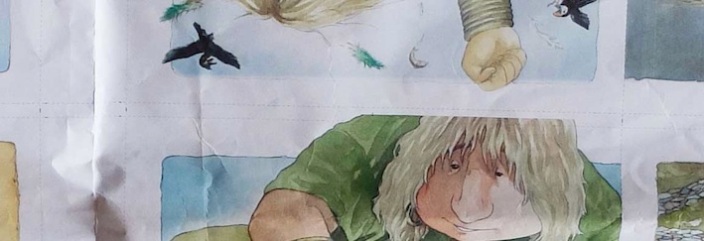Picturebooks are mostly 32 pages long for several reasons. One is paper size.
The maximum size sheet of paper a press can take depends on the size of the press itself. However, paper needs to maintain stability as it goes through the press and the larger the sheet in a four-colour print run, the more likely it will stretch slightly as it gets inked, causing the colour to go out of register. So there are limits to how large a sheet of paper is used for a picturebook run.
Depending on its dimensions, a 32 page book may be printed on 1 single sheet (16 individual pages on either side = 32), or split between 2 sheets of paper, each with 8 pages on either side.
The Sleeping Giant was printed on 2 sheets and the images below show the imposition proof of the first section. Because this is a test proof it’s on cheap thin paper. Also it has been rolling around our studio for several years which is why it’s so crumpled and tatty!

 I’ve added the page numbers on top so you can see the way the imposition works – the 16 pages are organised on the sheet so they will all end up in the right place when it is folded by the folding machine. Once the imposition sheet has been folded to check this, the print run can go ahead. The imposition print is also called the ‘blue copy’ because it was formerly printed only in blue.
I’ve added the page numbers on top so you can see the way the imposition works – the 16 pages are organised on the sheet so they will all end up in the right place when it is folded by the folding machine. Once the imposition sheet has been folded to check this, the print run can go ahead. The imposition print is also called the ‘blue copy’ because it was formerly printed only in blue.
On this close up of the imposition sheet you can see the fold/trim lines which don’t appear on the final printed sheets. Some artwork is ‘bleeding’ over the trim line. Illustrators always add ‘bleed’ (10-15mm) to images to allow for slight shifts when the folded section is trimmed on three sides.
 Picturebooks are many different shapes and sizes but ultimately they need to fit within a certain size of paper to be competitively priced. Sometimes publishers produce over-size books, or one which is extra tall or extra wide, and some picturebooks are pushed to 48 pages (an extra 16 pages/1 sheet) – but extra sheets mean an extra print-run & time & ink and all add to the cost. Picturebooks also come as 24 pages, 40, 56, but the pages are always in multiples of 8. You can’t add or subtract a random number of pages – say 2, or 4.
Picturebooks are many different shapes and sizes but ultimately they need to fit within a certain size of paper to be competitively priced. Sometimes publishers produce over-size books, or one which is extra tall or extra wide, and some picturebooks are pushed to 48 pages (an extra 16 pages/1 sheet) – but extra sheets mean an extra print-run & time & ink and all add to the cost. Picturebooks also come as 24 pages, 40, 56, but the pages are always in multiples of 8. You can’t add or subtract a random number of pages – say 2, or 4.
The thing is, while paper size and cost may be the main reason why the 32 page picturebook is the most common, it is a length which works very well. A 24 page book is quite short, so is often used for baby books, while 48 pages may feel like the story is being dragged out. 32 pages has a Goldilocks’ rightness to it!
Note for any illustrator thinking of creating their first picturebook: the publisher looks after these technical details of preparing the art for print. Also, they will decide the size and dimensions with you. If you want to rough up an idea within ‘acceptable’ dimensions try finding a book that is a size and shape which you feel suits your idea, and use its measurements as a guide. Bear in mind that paper sizes vary a little worldwide and that the publisher may suggest changes, so don’t get too wedded to an exact size too early in the process.

I love the way you introduce the subject of imposition to your readers. Very clear and non-threatening.
LikeLike
Thanks, Stephen. Always easier with visuals!
LikeLike